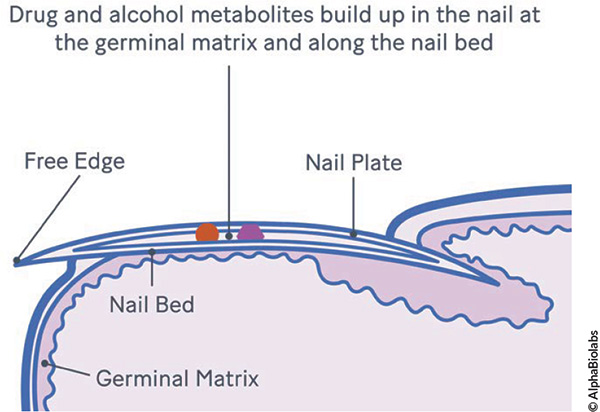*/
As a leading provider of UKAS-accredited drug and alcohol testing, and a trusted training partner of the Judicial College, AlphaBiolabs recently had the opportunity to deliver a session on drug and alcohol testing to over 80 members of the judiciary.
Among the many insightful discussions that took place, there was a noticeable interest in alternative testing methods to complement hair testing – particularly nail testing.
Here, we take a closer look at nail drug and alcohol testing, its evidential value and how it can be used to support or enhance other toxicology evidence.
Nail testing is a toxicological method used to detect drug use or, in the case of nail alcohol testing, to monitor abstinence or chronic and excessive alcohol consumption over an extended period.
When a person consumes drugs or alcohol, these substances and their metabolites enter the bloodstream and become embedded in the keratin fibres of the nails as they grow.

Once deposited, these markers remain stable, providing a retrospective overview of substance use.
Nail testing is especially useful when hair testing is unavailable or unsuitable. Common scenarios include:
In such instances, nail testing provides a robust alternative. It is also highly relevant in child protection cases, where long-term patterns of drug or alcohol use need to be evidenced swiftly to inform safeguarding decisions.
While nail testing can be conducted independently, its evidential power is amplified when used in conjunction with other testing methods. Combining nail drug or alcohol testing with hair, blood, urine or oral fluid analysis allows legal professionals to:
In alcohol testing, nail samples can complement blood biomarker testing – such as phosphatidylethanol (PEth) – to build a multi-source profile of alcohol use (proof of abstinence or supportive of chronic and excessive use). This is particularly valuable in care proceedings where establishing long-term parental behaviour is critical.
As toxicological science evolves, it’s essential for the legal profession to remain up to date on the full range of testing options available, particularly when decisions in court can have far-reaching consequences for families.
Nail testing offers a reliable means of evidencing long-term substance use and is effective as:
As a leading provider of UKAS-accredited drug and alcohol testing, and a trusted training partner of the Judicial College, AlphaBiolabs recently had the opportunity to deliver a session on drug and alcohol testing to over 80 members of the judiciary.
Among the many insightful discussions that took place, there was a noticeable interest in alternative testing methods to complement hair testing – particularly nail testing.
Here, we take a closer look at nail drug and alcohol testing, its evidential value and how it can be used to support or enhance other toxicology evidence.
Nail testing is a toxicological method used to detect drug use or, in the case of nail alcohol testing, to monitor abstinence or chronic and excessive alcohol consumption over an extended period.
When a person consumes drugs or alcohol, these substances and their metabolites enter the bloodstream and become embedded in the keratin fibres of the nails as they grow.

Once deposited, these markers remain stable, providing a retrospective overview of substance use.
Nail testing is especially useful when hair testing is unavailable or unsuitable. Common scenarios include:
In such instances, nail testing provides a robust alternative. It is also highly relevant in child protection cases, where long-term patterns of drug or alcohol use need to be evidenced swiftly to inform safeguarding decisions.
While nail testing can be conducted independently, its evidential power is amplified when used in conjunction with other testing methods. Combining nail drug or alcohol testing with hair, blood, urine or oral fluid analysis allows legal professionals to:
In alcohol testing, nail samples can complement blood biomarker testing – such as phosphatidylethanol (PEth) – to build a multi-source profile of alcohol use (proof of abstinence or supportive of chronic and excessive use). This is particularly valuable in care proceedings where establishing long-term parental behaviour is critical.
As toxicological science evolves, it’s essential for the legal profession to remain up to date on the full range of testing options available, particularly when decisions in court can have far-reaching consequences for families.
Nail testing offers a reliable means of evidencing long-term substance use and is effective as:


Chair of the Bar reflects on 2025
Q&A with criminal barrister Nick Murphy, who moved to New Park Court Chambers on the North Eastern Circuit in search of a better work-life balance
Revolt Cycling in Holborn, London’s first sustainable fitness studio, invites barristers to join the revolution – turning pedal power into clean energy
Rachel Davenport, Co-founder and Director at AlphaBiolabs, reflects on how the company’s Giving Back ethos continues to make a difference to communities across the UK
By Marie Law, Director of Toxicology at AlphaBiolabs
AlphaBiolabs has made a £500 donation to Sean’s Place, a men’s mental health charity based in Sefton, as part of its ongoing Giving Back initiative
Professor Dominic Regan and Seán Jones KC present their best buys for this holiday season
Little has changed since Burns v Burns . Cohabiting couples deserve better than to be left on the blasted heath with the existing witch’s brew for another four decades, argues Christopher Stirling
Six months of court observation at the Old Bailey: APPEAL’s Dr Nisha Waller and Tehreem Sultan report their findings on prosecution practices under joint enterprise
Despite its prevalence, autism spectrum disorder remains poorly understood in the criminal justice system. Does Alex Henry’s joint enterprise conviction expose the need to audit prisons? asks Dr Felicity Gerry KC
With automation now deeply embedded in the Department for Work Pensions, Alexander McColl and Alexa Thompson review what we know, what we don’t and avenues for legal challenge